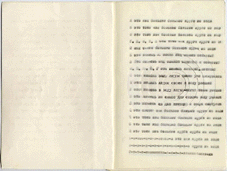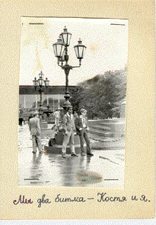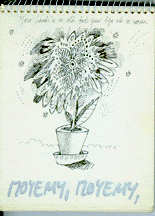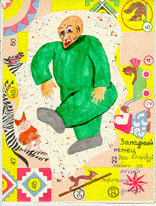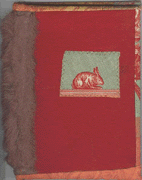
|
Präprintium. A Berlin Exhibition of Moscow Samizdat Books Other Voices, v.1, n.2 (September 1998) Präprintum runs from May 14th - June 27th, 1998 at the Staatsbibliothek, Potsdamer Strasse, Berlin, and from November 7th, 1998 to March 7th, 1999 at Neues Museum Weserburg, Bremen, Germany. The catalogue and CD-ROM (Präprintium. Moskauer Bücher aus dem Samizdat. Eds. Günter Hirt, Sascha Wonders. Bremen: Temmen 1998) costs 48 DM and may be ordered via email ed.temmen@t-online.de. Curator Georg Witte may be reached at georg.witte@rz.hu-berlin.de
Copyright © 1998, Stephen Küpper, all rights reserved. All illustrations taken from the CD-ROM, copyright Günter Hirt, Sascha Wonders, used with kind permission.
The Potsdamer Platz in the heart of Berlin has become Europe's largest building site. Where the Berlin Wall once marked the frontier between two opposed political systems Sony and Mercedes Benz are now constructing new headquarters, celebrating their victory in the Cold War. Already their unfinished skeletons dwarf the Staatsbibliothek where an exhibition bears witness to a small part of the bygone Soviet culture. This exhibition "Präprintium. Moscow Samizdat Books" displays a selection of books from the Moscow- based literary and artistic underground of the late Soviet Union. Trapped in a "pre-Gutenberg" situation with no hope of ever publishing their work, these artists turned political constraints into advantages, producing works that by their very facture fell out of the Gutenberg galaxy, building a whole poetic system on these foundations. The exhibition includes some 300 books, journals and text objects, mostly from private collections in Germany and Russia, that were produced under conditions which came to be known as samizdat or self-publishing. They represent around 90 individual authors, collectives, and editors who collected samizdat works and distributed them in journals with a typical circulation of 5 to 10 copies. Although the main body of the exhibition is limited to the Moscow samizdat of the late 50's to the early 90's, this is not to diminish the significance of the other metropolis, St. Petersburg, or the many efforts in the Russian province. The curators, Günter Hirt and Sascha Wonders, have drawn on their 15-year-long experience of the Moscow literary and art scene. They attempt to give a full picture of the various tendencies which gestated during Khrushchev's thaw of the late 50's and early 60's, further developing in the stagnation that was Brezhnev's rule, and only finally surfacing in the perestroika of the late 80's. As the exhibition documents, Russian unofficial literature has a long tradition. Ever since Ivan Fedorov, founder of the first Russian printing press and erstwhile protégé of Ivan the Terrible, was exiled from Moscow for his activities, book-printing in Russia has been under the close scrutiny of the authorities. Most major 19th century writers, including Pushkin, Gogol, Tolstoy and Dostoevsky, had problems with publication. Works either did not pass the censor's watchful eyes or were subject to serious "editing". Others, like the Russian Old Believers that split from the Orthodox church in the 17th century, did not even write with the intention of publishing in print. This tradition is documented by some examples of historical samizdat books from the Lenin library in Moscow. Among these are a handwritten book by Russian Old Believers dating from the 18th century; no less than three different lithographed editions of Tolstoy's Kreutzer Sonata; and the remains of a torn-up edition of Pushkin's more libertine poems. One of the few surviving copies of Radishchev's 1803 Journey from St. Petersburg to Moscow, complete with annotations by the censor, lies next to an edition of Aleksandr Griboedov's play Woe From Wit in which the censored parts are restored in handwriting. In the early 20th century, Russian futurist artists and writers were the first to start a tradition of artists' books that were not meant to be circulated in larger numbers. Four futurist book objects from the 1910's testify to the obsession with extravagant typography and the "letter as such" (bukva kak takovaya). Among them is the notorious Zaumnaya gniga (Transmental book) that introduced zaum', a poetic language intended to transcend all national languages, and features a hand-printed cover with a sewn-on button. In the 1930's and 40's, many early 20th century classics fell victim to Stalin's repressions, and not until the advent of perestroika were their works published in the Soviet Union. During that period they were preserved in modest handwritten or typed booklets diametrically opposed to the official book culture. One Stalinist parade book on exhibition, celebrating the achievements of Soviet steel industry, is in fact bound in steel sheets embossed with a profile of Stalin. After Stalin's death, samizdat gained such enormous momentum that its significance clouded "official" literature. Obviously, its status was highly ambiguous. On the one hand, every citizen had the right to distribute his writings in up to five copies. On the other hand, everything that was written, let alone typed, without official knowledge aroused the suspicion of being anti-Soviet propaganda. Although this was true for some samizdat texts, in many cases this was a gross exaggeration. Samizdat reported on the violation of Human Rights, which was documented in the Khronika tekushchikh sobytiy (Chronicle of Ongoing Events), one of the most widespread samizdat publications. It circulated Solzhenitsyn's Gulag novels as well as political and religious treatises, translations of foreign works, erotic novels and pornographic trash. While preserving the Modernist and Avant-garde traditions, it also distributed new poems, songs and novels. It appears that the term samizdat was coined in the 1940's by the poet Nikolay Glazkov, who designed the covers of his books to resemble official publications, but signed the title pages of his self- made books samsebyaizdat (published by myself) in the place typically reserved for the publisher's name. Three of his typewritten books are contained in the exhibition. Glazkov was also among the first to consider the situation of the unpublished and unpublishable poet. In one of his poems he reflects that being turned into a monument is no better than not being published at all, and ends with the statement that "my profession is to become a poet". His 21st Book (1961) bears the defiant motto "Only those poems enter eternity that are as strong as cognac" (Stikhi lish' te voidut v veka / V kotorykh krepost' kon'yaka). Evgeny Kropivnicky styled himself as a "poet on the edge". This is to be taken literally. Kropivnicky, a former Petersburg art student, survived Stalinism in Lianosovo, a shantytown suburb of Moscow. After Stalin's death, when it seemed possible for modernist art to re-enter the canon, Kropivnicky's room became a center of attraction for young artists and poets as well as for officially recognized figures. Kropivnicky's collections of poetry describing shantytown life are frequently written by hand, bound in cheap fabric or painted with naive flower motives, adding a touch of homeliness. Later they would acquire cult status and circulate in "authorized" copies signed by the master himself. Following a series of close brushes with the powers-that-be in the early 60's, it gradually became clear that for some there was no place in Soviet publishing houses. Khrushchev's deposition in 1964 only confirmed this. During the ensuing stagnation samizdat came into its own. Poets started exploring the possibilities of manufacturing books that were never meant to be printed. A book of haikus by Genrikh Khudyakov (1968) has the first word of every poem calligraphed in pseudo-eastern style in a frame on the left side, as if illustrating the poems. In addition, the book is folded according to a complicated pattern that is reminiscent of Japanese origami art. The growing importance of book design is discernible, too, in the works of Kropivnicky's pupils, Genrikh Sapgir, Igor Kholin and Vsevolod Nekrasov. Whereas one of Kholin's early books, dating from 1952, is written with colored pencil in an accountant's booklet, his most recent work Seksual'noe istomlenie (Sexual exhaustion, 1993) is painstakingly calligraphed in white letters on heavy black paper and illustrated by artist Viktor Pivovarov. Sapgir was among the first to transcend the book format, producing a series of sonnets written on the back of shirts. Nekrasov's experiments with repetitious patterns lead him to visual poetry. His works are usually a quarter of a page in size and sometimes contain only a few words and punctuation marks. This throwaway design is mirrored by the poetry itself - everyday phrases repeated over and over again, accidentally discovered poetic structures in common speech, unexpected sense growing out of phonetic likeness. One poem simply reads: "Maybe / one may live. And maybe / one may leave", with the last word written over the edge of the paper. This use of everyday speech would eventually lead to the complex play of ideologies in Moscow Conceptualism, probably the most influential, and at any rate, the most visible form of samizdat art. Several of its practitioners are now recognized worldwide. First and foremost is Ilya Kabakov, now a major installation artist. In the early 1970's he produced a series of albums seminal for Moscow underground art in their combination of images and texts. None of the original albums are on display in the exhibition. However, there is a reworking of the album Shutnik Gorochov (The Joker Gorokhov) made by Kabakov himself, and titled Peredacha energii (Transmission of Energy). Photographs of the album pages are glued onto pages of the journal Ogonek and connected with bits of string, while the original text is written in ballpoint on the margins. Moreover, the CD-ROM that accompanies the exhibition catalogue contains two booklets, Divan-Kartina (Sofa- Painting, 1979) and Avtomat i cyplyata (Submachine Gun and Chicks, 1979), which describe fictitious exhibitions of Kabakov's eponymous pictures, painted in the 1960's. The descriptions of these virtual shows, complete with spectators' reactions, turn the unofficial artist's inability to exhibit his works into a new art form which would eventually lead to Kabakov's later installations. The works of conceptual poet Lev Rubinshteyn consist of small textual fragments, each written on a separate piece of paper, which are read by the author, leafing through his pages, in a small poetic performance. Programma sovmestnykh perezhivaniy (Program of communal events, 1981) is to be read in a small group, handing the single cards from one participant to the other. While this form of presentation makes Rubinshteyn's texts virtually unpublishable, his works are a prime example of turning the limitations of samizdat into advantages.
Poet and visual artist Dmitry A. Prigov goes even further in some of his work. His 18-ya Azbuka (kamen' i krugi na vode; 18th Alphabet, The Stone and Circles on the Water) consists of six carbon copies of which only the last is readable. Prigov both stages the appearance of the text and plays on the fact that because of the way of copying, many samizdat typoscripts are extremely hard to read.
Books like the 24-ya Azbuka (lokhmot'ev; 24th Alphabet, Shreds) and 25-ya Azbuka (ostatkov ot lokhmot'ev; 25th Alphabet, Leftovers from the Shreds) consist of torn-up and crumpled pages. His Pervy sbornik vyrvannykh, vydrannykh, vybroshennykh, izmyatykh, istertykh i porugannykh stikhov (First Collection of Torn-up, Torn-out, Thrown- away, Crumpled, Ground and Accursed Verse) is just that: a collection of the poems that even Prigov himself, whose aim it is to write 24 000 poems by the year 2000, did not consider fit for samizdat publication. Their inclusion in a collection may be read as a invalidation of the boundary between "good" and "bad" unofficial literature and also as a meditation on Prigov's own conceptual graphomania. Eventually, complete unreadability is achieved in the series Grobiki (Little Coffins), which consists of booklets bound on all four sides with staples. Samizdat developed a system of chronicling its own activities. Numerous journals were issued, often with a circulation of 5 to 10. The exhibition features the Moscow art journals Metki and Kolkhos; Transponans, an extremely advanced journal for neo-futurist art edited by Ry Nikonova and Sergey Sigey in the small provincial town of Eysk on the Asov Sea; Leviathan, a handwritten journal edited in Israel by émigré Mikhail Grobman; and early samizdat editions of Sintaksis which after the emigration to Paris of its founder, Aleksandr Ginzburg, was to become a leading organ for Soviet unofficial art and literature. There is also a weighty volume of MANI, the Moscow Archive of New Art compiled by various artists during the early 1980's when it was felt that the period of "high" conceptualism was drawing to an close; and the collection Po masterskim (Through the Ateliers) by Vadim Zakharov, a member of a new generation of artists. The latter was intended as a description of the Moscow underground art scene, but caused quite a stir for its irreverence towards the established masters. The sternness of Conceptualism was indeed subverted by a younger generation of artists, Zakharov for one, who around 1980 initiated a "new wave" in unofficial art. Konstantin Zvezdochetov, Nikita Alekseev, the Mukhomor (Toadstool) group and others abandoned the complex signifying structures of Conceptualism in favor of a colorful, pop- influenced artistic activity exhibiting a strong emphasis on improvisation and spontaneity designed to "stop making sense".
Nikita Alekseev's Meditatsija (Meditation, 1986) seems to ruminate endlessly on secrets of love and life, but in the end simply asks, "Every morning, why do I ponder whether I was right to wake up?"
A later wave of conceptualism took these provocations into account. Sergey Anufriev and Pavel Peppershteyn of the Medical Hermeneutics group joined forces to produce the novel Mifogennaya lyubov' kast (The Mythogenic Love of Castes), set in a half-mythical Soviet Union where abnormalities lurk behind every corner. Several volumes of this novel have already been completed in outbursts of free improvisation, with the handwriting changing every now and then as one author takes over from the other. Peppershteyn's and Anufriev's illustrations are a synthesis of the stern style of conceptual artists like Kabakov and Pivovarov (Peppershteyn's father) and the colorful throwaways of the "new wave" books. Peppershteyn's own books, too, feature carefully executed drawings whose surrealism is a compilation of genre pieces, Soviet commonplaces, ancient mythology, and Western commodities.
Cyrillic letters on the skies spell "Rockwell". In hommage to Kabakov, Anufriev applies his own photographs and texts onto the pages of German travel guides. One of his creations is thus titled Intertekstual'ny putevoditel' (Intertextual Travel Guide). Artist Yury Al'bert produced a book that describes pictures by van Gogh in braille, questioning the status of viewing and reading (Avtopotret s zakrytymi glazami; Self Portrait with Closed Eyes). With the advent of perestroika and the subsequent end of the Soviet Union, there was no longer a need for artists to restrict themselves to virtually unpublishable book objects. As the most recent exhibits show, however, samizdat poetics have survived their original context. What used to be a gesture of defiance to both official culture and those unofficial artists who strove to enter the canon, has now turned against the new constraints of a market-oriented literature that consists mainly of thrillers, erotic novels, and Dale Carnegie's How to Win Friends and Influence People. In 1992, the publishing house Renaissance was able to finance the publication of Rubinshteyn's texts through a huge output of mass literature. In the meantime, many poets and artists have had to revert to small publishers or a style of samizdat which, though no longer illegal, results in no higher circulation. Leonid Tishkov is one such publisher who produces bibliophile books in limited editions that still allow hand painting and editing. By addressing collectors directly, he eliminates the need to worry about distribution. Pavel Mityushev uses computer technology to produce books in miniature format. His Putevoditel' po Rossii (Travel Guide to Russia, no date), is less than one square inch in size and is placed in a box to draw attention to it. His Belaya kniga (White Book, 1995) consists of one floppy disk. Vadim Zakharov, now based in Cologne, Germany, publishes his journal Pastor in tiny circulations using an Apple Macintosh, retaining much of the original samizdat flavor. A similar journal is Mesto Pechati (Place of Print), edited in Moscow by the publishing house Obscuri viri, specializing in postmodern marginal literature, art, and philosophy. Some artists have returned to the Gutenberg galaxy for short, sharp shock visits. The cover of the Moscow art journal Radek shows the editors with their trousers down in front of the burnt-out Moscow White House. This issue was the only one that ever went to press. After this foray into the Gutenberg galaxy the journal was transferred to the internet. There is also the collaboration by Oleg Kulik, member of Radek, and the notorious author Vladimir Sorokin. Their book V glub' Rossii (In the Depths of Russia) features the kinds of texts for which Sorokin is famous (or infamous) -- celebrations of violence, sex and coprophagy inserted into immaculate stylizations reminiscent of the best of Russian prose. The photographs of Oleg Kulik are entirely in keeping with the texts. Between shots of idyllic landscapes the artist is shown copulating with farm animals. Other artists have stuck to the pre-Gutenberg format and continue the production of visual poetry and books objects. Anna Al'chuk pierces patterns in book pages with a needle. Nadezhda Stolpovskaya folds her books into complicated patterns, and Nikolay Baytov superimposes geometrical patterns on his typewritten texts by sticking stamps on them and connecting these with colored felt pen lines. Munich-based émigré Julia Kisina produces books that are bound in cheap fabric and lined with fur bearing an uncanny resemblance to Kropivnicky's books found at the very origin of the genre.
This is of course only a brief overview of the riches that the exhibition has to offer. There are concertinas of photographs of actions by performance artists Francisco Infante and the Collective Actions group. There is Tri razvorota (Three Open Pages) by conceptual artist Andrey Monastyrsky, an object that consists of a book on insects which contains a golden beetle hiding inside a hole in its pages. One book that, strictly speaking, goes beyond the scope of the exhibition, nevertheless deserves to be mentioned here. It is a tiny work (1"x1.5") made in 1953 by a German POW in the labor camp of Vorkuta, open to a page that contains the saying "Humor ist, wenn man trotzdem lacht" ("A sense of humor is laughing in spite of all odds"). The catalogue and CD-ROM that accompany the exhibition take the pre- Gutenberg exhibits into the Gutenberg galaxy and out again. The CD-ROM contains reproductions of 36 objects. Each page is scanned individually, allowing readers to leaf through the books and read the texts accompanied by a German translation. The books, whose presentation in glass vitrines turns them into museum objects, are in this way resurrected in virtual space. This process leads to a curious tension: the presence on the screen only serves to highlight the absence of the objects, all the more so, as they display their objecthood by virtue of their facture and even more by their presentation under glass. The virtuality of the computer images was matched by the presence of many of the artists at the opening of the exhibition. As with the books on the CD-ROM, the long-shattered Moscow underground congregated as a virtual community for a meeting that could never have taken place under underground conditions. In between the pre-Gutenberg exhibits and the post-Gutenberg virtual representation, there is the Book. The catalogue may serve as a metonymy for the vast theoretical commentary that has grown around the original works in the last decade, after the underground began to appear in public, i.e. in print. It contains a lengthy essay by the curators on samizdat book culture and its roots in the Russian tradition from icon-painting onwards, and also a meticulous description of the individual exhibits. This apparatus helps to contextualise and understand the often cryptic books which, like Snow White in her coffin, are removed from direct contact. Significantly, the description concentrates on the objects' facture rather than the texts and their poetics. Again, the exhibition of the books and their mechanical reproduction in the catalogue leads to the burial of the actual texts under a description of their outer design. Only in virtual space are they revived. The step into the Gutenberg galaxy that the underground scene took after perestroika has led to the objectification in history of their original efforts -- the vast literature on them has all but overgrown the actual texts. This review takes this process one step further into the future as the exhibition is removed in time, space, and medium. The CD-ROM recreates in virtuality the private space that samizdat originated in. By making this virtual privacy public, this review serves as an analogon to the exhibition in cyberspace. If the editors call the CD-ROM a "late vengeance of the unprinted books" (p. 6), this may well be taken as a reinstatement of the texts into their rights. It is only in virtual space that the contact with the books, those messengers from a bygone culture, can take place. And if this is within sight of the Sony headquarters, then indeed the marginal culture of Moscow samizdat has planted itself right in the center.
Further reading in English: Andrew Solomon, The Irony Tower. Soviet Artists in a Time of Glasnost. New York, 1991. Charles Doria (ed.), Russian Samizdat Art. New York, 1986. Kent Johnson / Stephen Ashby (eds.), Third Wave. The New Russian Poetry. Ann Arbor, 1992.
|


